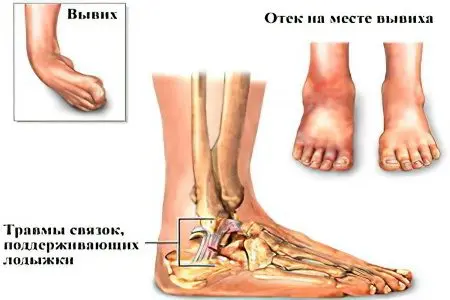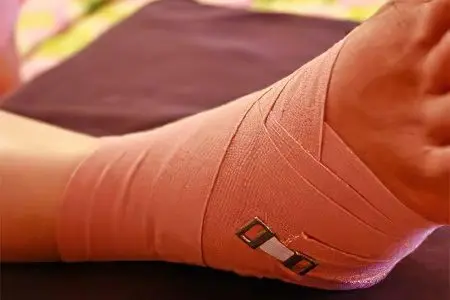Contents
Of all the injuries of the limbs, the most common injury should be considered to be a dislocation of the leg. According to statistics, it is most often encountered by people aged 20 to 50 years, and this makes up about 15% of the total number of injuries. Children under the age of 10 get dislocations of any type in only 5% of cases. This is because the ligamentous apparatus at a young age can easily withstand significant loads. If we talk about older and older people, then their dislocations are as rare as in children – no more than 5%, but this fact is already explained by careful and unhurried movement.
Dislocation-related leg injuries also include:
Achilles tendon rupture;
sprain of the ligamentous part of the ankle, which occurs quite often.
Symptoms of a dislocated leg

Dislocation of the leg is accompanied by characteristic symptoms, and the main one is very strong, excruciating pain in the area of dislocation. It is felt not only at the moment of injury, but also in the future, when trying to load or move the limb.
On the part of the leg that turned out to be damaged, a change in the shape of the joint may be noted, edema, areas with multiple bruises and painful swelling, which subsequently turn into hematomas, may also occur. In the absence of timely treatment, symptoms such as numbness and even paralysis appear. It is always noted below the place that was affected. Paralysis can be caused by significant pressure on blood vessels and pinching of nerve fibers during dislocation.
Any attempts to change the position of the victim’s leg are accompanied by severe pain, and therefore it is necessary, after first aid, to provide him with complete rest until the specialists arrive. It is also important to remember that compression of nerve endings can be a catalyst for numbness of the injured limb.
Complications of dislocation of the leg are:
rupture in the area of muscles, ligaments and tendons;
damage to the nerves and blood vessels in the area of the joint that was dislocated. These complications can occur both together and independently of each other;
increased likelihood of re-dislocations of the leg;
the formation of arthritis in the area of the dislocated joint (this complication most often manifests itself years later, at an older age).
Causes of dislocation of the leg

An injury such as a dislocated leg can occur due to a number of reasons – for example, due to a fall from a not very high height, a direct or indirect blow to the leg or ankle. Also, dislocation can occur as a result of sprained ligaments of the leg.
Most often (in 90% of cases) dislocation of the legs is the result of any injury. The remaining 10% are congenital defects that form in the unborn child at the stage of intrauterine development. Congenital dislocation of the leg does not appear immediately, usually only when the child is already learning to walk. It is important to identify this deviation as early as possible in order to carry out successful treatment.
Types of dislocation of the leg
In the process of diagnosis, the doctor determines which type the resulting dislocation of the leg belongs to. If the articular bags are completely displaced relative to each other and at the same time do not have points of contact, such a dislocation should be considered complete.
With inferior dislocation (or subluxation), contact of the joints is observed, but only partial. It should be noted that such an injury is always accompanied by a rupture of the joint capsule. In certain situations, a tendon rupture can even occur, and hemorrhage begins in the area that has been damaged.
Separately, it is worth considering this type of dislocation of the leg, as usual. This is a dislocation that occurs more than twice in one specific area. If, after the first dislocation, you do not seek qualified help from a specialist in a timely manner, the risk of a recurrence of the situation is very high. Timeliness is also required for diagnostics, which must be carried out literally in a matter of hours.
Diagnosis of dislocation of the leg
In the process of diagnosing a dislocation, the presence of such an injury in the medical history should be taken into account. Visually, the specialist notes a change in the skin in the area of the damaged joint; forced position in which the limb is located; change in its length in relation to a healthy leg.
It is imperative to examine the pulse on the limb that was dislocated, and determine the degree of its sensitivity.
For the most accurate diagnosis, an X-ray of the leg or an ultrasound examination is performed (if it is impossible to conduct an X-ray).
Treatment of dislocation of the leg

Qualified treatment of a dislocated leg is very important, because if it is not done on time, serious complications are likely. It is categorically impossible to correct a dislocation of a limb on your own, without being a specialist. Only an experienced specialist will be able to carry out an adequate diagnosis of the injury and set the joint without worsening the condition of the victim.
The algorithm for the primary treatment of dislocation of the leg looks something like this:
In order to relieve a sharp pain, the victim must be given any painkiller. Then the injured limb must be immobilized, this is done with the help of a splint. It is not difficult to make it from any solid material at hand. It can be a wooden board, an iron rod or something else, the main thing is that the tire is straight enough;
A cold compress applied to the injured area will help reduce swelling. It is permissible to use ice or cold lotions for this purpose, which are best done with a towel moistened with water;
In this condition, the victim should be taken to a nearby trauma center for subsequent X-ray examination, diagnosis and treatment.
It is important to determine what kind of injury we are talking about, that is, to differentiate a dislocation from a fracture and other injuries. If the diagnosis of “dislocation” is still confirmed, then the joint should be set. When repositioning a limb, all actions must be performed extremely slowly, without any jerks. This will help avoid further damage. In certain situations, the reduction of the dislocation by the manual method is impossible, then the doctor has to resort to surgical reduction.
After the dislocation of the leg is set, an elastic bandage or special dressings are applied, which are called splints. They are selected depending on the severity of the dislocation: the more difficult it is, the more rigid the material should be.
It is extremely important to fix the injured leg in the usual position. That is, only such a plaster splint is applied, which can provide peace to all muscle groups and rapid healing of the damaged joint capsule. Wearing a splint can last from three to 10 weeks. This period depends on the characteristics of the dislocation and the severity of the injury.
With severe pain, the patient is allowed to take painkillers. But it is permissible to do this only in small quantities, so as not to cause subsequent addiction of the body.
With the formation of the so-called habitual dislocation, it is necessary to carry out surgical intervention. In this case, the arthroscopic method is used, that is, the operation is carried out without incisions, exclusively through punctures. A specific optical device called an arthroscope is inserted into the cavity of the leg joint through a puncture.
It enables:
to examine the articular area;
identify damage to the ligamentous apparatus;
determine the ultimate cause of instability.
Through another puncture, special instruments are introduced into the joint area, which make it possible to attach or adjust the articular area. Its subsequent fixation is carried out using self-absorbable fixatives, which are called anchors.
With proper arthroscopic surgery, success is guaranteed in 95% of cases.
Prevention and rehabilitation

After the gypsum has been finally removed, physiotherapy is carried out, and the appointment of exercise therapy exercises (therapeutic physical culture) is also very useful. It is physical education that helps to develop the joint that has been damaged.
It is advisable to divide the prevention of dislocation of the leg into three equivalent stages:
At the first stage Prevention is very important movements in the knee and hip joints of the injured limb. Thanks to regular movements, a significant improvement in the supply of blood to the limb, as well as a modification of the tone of all leg muscles without exception, is planned. If a specialist, as part of the first stage of prevention, allows the victim to move in a plaster cast, then the person must ensure that the foot is correctly placed. This is done in order to avoid fixing the wrong position of the leg, which in the future may provoke the need for surgical intervention;
The second stage treatment (when the cast has already been removed) is that the patient should pay special attention to training precisely those muscles that strengthen the arch of the leg. If a dislocation of the foot occurs, only orthopedic insoles should be used to support the leg. They are called supinators. After the completion of the second and at the beginning of the third stage, the victim can proceed to a very careful restoration of the spring activity of the leg. To this end, it is necessary to carry out not very large jumps and all kinds of jumps. It is recommended to do this on a soft surface (on a carpet or a special mat);
As part of the third stage prevention, it is necessary to achieve the restoration of full-fledged motor activity of the leg. This can be achieved with the help of special gymnastic exercises and physiotherapy exercises. It is important throughout the course of prevention not to deviate a single step from the instructions that were given by the specialist. This will allow you to count on the fastest possible recovery and bringing the leg back to normal.
A positive effect can also be achieved when performing passive-type gymnastics, in which the victim keeps the leg immobile, but at the same time strains the muscles in the area that was injured. Regular performance of such exercises significantly modifies blood circulation and maintains muscle tone, thereby preventing muscle atrophy.
Additional and no less important measures in the prevention of dislocations of the leg should be considered:
An optimally composed diet, which includes foods enriched with calcium and vitamins;
Frequent but gentle physical activity.
Equally important is the choice of comfortable shoes. It should be not only comfortable: on a flat sole, spacious enough; but also correct – at least, we are talking about special orthopedic insoles.
Thus, dislocation of the leg is fraught with serious complications and needs quick and qualified treatment, which will make it possible to avoid a recurrence of the problem in the future. Equally important is prevention and rehabilitation, which will speed up recovery after a leg injury.









